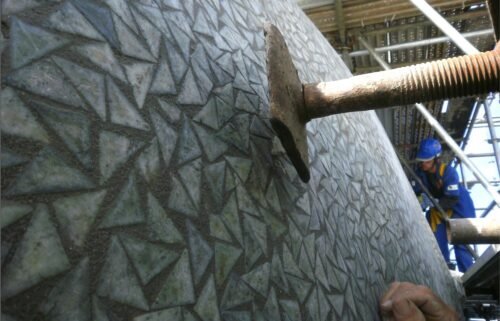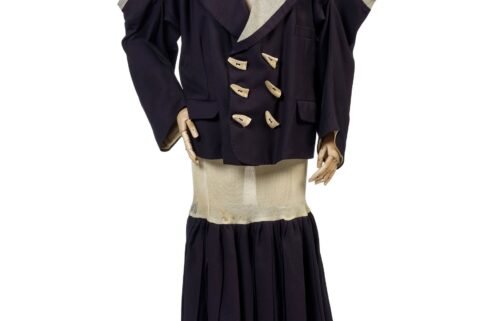A conflict photographer captures a moment of brotherhood between two soldiers
(CNN) — At an outpost in Afghanistan’s eastern Korengal Valley, in the midst of a heightened American military campaign against the Taliban, two soldiers appear to be fighting — each other. It’s a play fight and the young man on the bottom has his comrade in a headlock, forcing a kiss on the cheek.
The photograph, taken in 2008 by the late British photographer Tim Hetherington, is from a time when nearly a fifth of all combat in Afghanistan was taking place in the six-mile valley.
In the long stretches of boredom that would arise when the enemy was nowhere to be found, the men had to find other things to do at their remote outpost.
“These guys are tough, aggressive guys and when there wasn’t any combat, they turned their aggression on each other — in a fraternal way,” explained Sebastian Junger, a writer and journalist who first brought Hetherington to Afghanistan on an assignment for Vanity Fair magazine in 2007.
Both Hetherington and Junger became “enamoured with the opportunity to show the intimacy of a platoon in combat,” Junger said in an interview via telephone. The pair went on to co-direct what would become the Oscar-nominated documentary “Restrepo” filmed over the course of the same platoon’s deployment.
Bobby, the soldier on the bottom of this image, is remembered by Junger as “incredibly funny, extremely smart.” On top is Cortez, “an incredibly sweet kid,” said Junger, adding that he was “sort of the pretty boy in the platoon.”
The photograph is currently on display at London’s Imperial War Museum (IWM), accompanied by an excerpt from Hetherington’s journal written that same year: “In the end it has little to do with the war, and a lot to do with being men… Or in the case here, becoming men.”
The works form part of an exhibition called “Storyteller: Photography by Tim Hetherington,” which opened on the 13th anniversary of the photographer’s death (he was killed by shrapnel while filming and photographing the Libyan Civil War in April 2011).
Junger agrees with his friend’s sentiment. “One of the things that place is very good at is turning children into men. And I think that’s always been true of war.”
Young men in conflict
“The experience of war was the only opportunity that men had in a society to express unconditional love for each other,” is a quote that Hetherington often repeated, according to his friends.
He first learned it from another friend, photographer James Brabazon while the pair waited with Liberian rebel forces who were going to attack the capital Monrovia, during the Liberian Civil War in 2003. It was Hetherington’s first experience of combat.
Brabazon first heard the saying from his grandfather, a British soldier who served in World War II. “He just clearly, really took it to heart,” said Brabazon in a video interview with CNN. “Tim was really interested in the dynamics of young men… He was really interested in how young men related to one another, how they represented one another to each other, where those representations came from, how they were amplified and how they were perpetuated — particularly in conflict.”
In a remote outpost where society was “stripped away,” these bonds captured Hetherington’s attention more than the war itself.
“I became much more interested in the inter-relationships between the soldiers and my own relationship to the soldiers than I was in the fighting,” reads a quote from Hetherington in the exhibition. “My examination of young men and violence, or of young men… It’s as much a journey about my own identity as it is about those young soldiers,” he wrote.
Following his year in the Korengal, Hetherington published “Infidel,” a photography book of stills taken during his deployment with bits of commentary from himself and the US soldiers he was embedded with.
One contributor is Cortez, one of the subjects of the photo, who wrote: “I told them time and time again that if a grenade went off, I would actually throw myself on the grenade… Because I actually love my brothers. I mean, it is a brotherhood… I think any of them would do it for me also.”
‘It’s very important that this work happened’
The IWM, which holds the entire archive of Hetherington’s work, worked with researchers and different communities to find out how they engaged with conflict photography. Greg Brockett, who curated the exhibition, was especially interested in how refugee communities would respond to Hetherington’s work.
“It’s very difficult to say how people are going to respond… Because a lot of them have experienced war and conflict directly,” he told CNN over a video interview. “What struck me was there was generally an overwhelming sense of people who felt it’s very important that this work happened, and people were able to see the realities they experience.”
“I’m less interested in people taking away knowledge of Tim, I’m more interested in people taking inspiration away from Tim,” said Stephen Mayes, executive director of the Tim Hetherington Trust, who also spoke to CNN via video call.
Hetherington was distinguished from other conflict photographers by his approach, which involved spending prolonged periods of time with his subjects. He often used film cameras and would speak to his subjects while photographing them.
“He wasn’t interested in photography in and of itself, for its own sake. He was interested in how that would allow him to access the lives of others,” said Brabazon.
‘It took a little bit from his soul’
In this process, Hetherington worried about how photography could be extractive. “He wanted the process to be consensual and also to leave something in the community,” added Brabazon, recounting a series of street photographs Hetherington took in Liberia where he would take photographs of people, keeping one Polaroid for himself and giving another to the subject.
“I think that was really important, because it allowed people to have agency in the work that was being created… It’s about extending the courtesy of participation in the creation of the work to the subject themselves.”
Hetherington’s friends reflect on the tragedy of his death in Libya, believing he was killed in his prime as a photographer — not only because of the images he produced, but because of his reflections on what it meant to capture conflict.
Mayes mentions the old adage that making a picture takes a little piece of the subject’s soul. “Tim thought, definitely, in his mind, he’d sold his soul to the devil in a way, because he saw that in making every picture he made, it took a little bit from his soul.”
“What did Tim want the effect of his work to be? That is a question which I don’t think we will every really know the answer to, because he died in the process of working that out himself,” Brabazon explained.
In his final diary entry on April 19, 2011, Hetherington wrote about attending the funeral of a rebel fighter who was killed by a mortar. He wrote of the young men he met there: “They are grimily happy that we are here to help them. They feel that now the whole world can see.”
The-CNN-Wire
™ & © 2024 Cable News Network, Inc., a Warner Bros. Discovery Company. All rights reserved.
“Storyteller: Photography by Tim Hetherington” is on at London’s Imperial War Museum until September 29.


